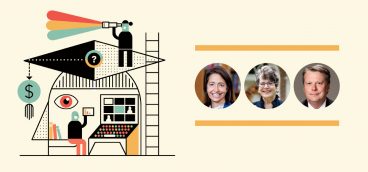
The professor sits at her console and looks to the monitor at her right. There, she sees the smiling, eager faces of her students, 16 strong, for this evening’s lecture. She greets them and is greeted in return.
On the monitor to the professor’s left is a SMART Board, an interactive whiteboard that she uses to emphasize portions of her lecture. The students, who are scattered across the country, see the lecture and the points of emphasis in real time. The lecture itself, enlivened by music and animation, looks as if it might have been produced by MTV.
Finally, the professor calls up a document from an online source, displays it and directs her students to break into small groups, then return in a few minutes to make a presentation on the document. The students, who can see each other just as the professor can see them, retreat to secure cyber “rooms” to complete the assignment.
This is how distance education is conceived and delivered at the Carnegie Mellon Tepper School of Business’s Part-Time Online Hybrid MBA Program, but it’s a far cry from your father’s distance education. At CMU, virtual classrooms are enriched by cutting-edge technology that makes online classes about as close to face-to-face exercises as possible.
“It’s really fairly amazing how close to an in-person experience you can create with technology that’s relatively inexpensive,” says Robert Monroe, director of the program and a faculty member as well. “It certainly has allowed us to create an experience that is a lot closer to what you would get by sitting in the same room with somebody. We tend to hold that up as the gold standard.”
The program is so highly regarded that it’s been ranked between No. 1 and No. 7 in U.S. News & World Report’s “Best Online Graduate MBA Programs” survey.
For Goodness Sake, We’re Carnegie Mellon
As recently as 2009, CMU’s program was more cutting-room floor than cutting edge, victim of a faltering economy and a dysfunctional model. Previously, the university had targeted its part-time, online program to large corporations, which paid a substantial sum for classes delivered to their employees. When the recession hit and corporations cut back on such niceties as employee education, CMU’s program was all dressed up with nowhere to go.
It wasn’t CMU alone that stood at the crossroads; the whole concept of distance education was under the microscope. In many cases, no matter the level of education, distance learning had not advanced very far past static video, with very little real-written time interaction between instructors and their students.
Early in the 21st century, however, a few pioneers began to adapt new technologies for distance learning, with stunning results. One such innovator was Salman Khan, who, in 2006, began delivering tutorials—complete with animation—via YouTube. By 2012, his nonprofit Khan Academy was a $15.8 million business. Another trendsetter was Udacity, which, flush with support from Google, AT&T and other tech giants, since 2011 has been offering online courses in such technical disciplines as web and mobile game development that lead to certifications that Udacity calls “nano degrees.”
“Students can sign up for classes, on a class-by-class basis, in whichever format works best for them.” —Robert Monroe
These developments, coupled with concomitant advances in the delivery of high-definition video, made it possible for education providers to reenvision and reboot their online programs. Distance education has surged as a result.
According to the National Center for Education Statistics, in 1999–2000, 8 percent of undergraduates and 2 percent of graduate students were enrolled in at least one distance education course. By 2012-13, those figures had risen to 26.5 percent and 30.8 percent, respectively. Interestingly, in 2012–13, 73.6 percent of college students were not enrolled in any distance learning courses, an indication of how much more growth is possible.
“What we saw,” Monroe recalls, “was a combination of fast, inexpensive video and online learning tools that had become very good. Online tools that help people run classes had advanced tremendously in the previous 20 years.”
CMU empaneled a committee to help determine the future of its program, and it wasn’t at all clear what direction the group would recommend.
“We could be a laggard or we could be a leader,” Monroe says. “For goodness sake, we’re Carnegie Mellon. If it involves online technology and computers, we should certainly be a leader. So we dove in with gusto and made a substantial investment.”
Turning Traditional Education Topsy-Turvy
That investment included the development and equipping of two on-campus studios to serve as the hub of the online component. With that completed, additional equipment was relatively inexpensive. But the online experience is only one of three elements of the reimagined program.
A second component is in-person “access weekends”—held at CMU’s campuses in Pittsburgh, New York or California—that kick off each semester. The weekends are crammed full of testing, tours of businesses, grounding in CMU’s ethics and expectations, and socializing.
The program’s final element is called “asynchronous learning,” that time between classes when students largely direct their own studies, perhaps doing class assignments, perhaps gathering online with other students for collaborative assignments. Monroe calls this feature “homework on steroids.”
These three elements—access weekends, online classes, asynchronous learning— are the heart of CMU’s program, and they’ve turned traditional learning, even traditional distance learning, topsyturvy in a variety of ways. Among them:
Seamless shifting among formats. The university also offers its MBA program on campus in both full-time and parttime formats. Students who need to shift from one format to another can do so without losing time or credits.
“Students can sign up for classes, on a class-by-class basis, in whichever format works best for them,” Monroe says. “Some people who would have a hard time finishing their degrees because of life events, such as a spouse’s transfer to another city, now can do so.”
Show time for professors. With the availability of modern computer graphics, animation and music, professors can insert as many such effects as they dare to make their lectures more compelling. All online lectures are archived, so the bells and whistles are archived with them. Does that mean professors must double as video producers?
“We tried that the first year and found professors are very bad technical editors,” Monroe reports. “It’s a terrible use of their time.”
Now, faculty work with CMU’s technical services staff to create their enhanced lectures.
Guest lecturers from anywhere. Some courses may feature up to a handful of guest lecturers, in part because such invited experts can access the class so easily. With the simple addition of software to a phone or laptop, guest lecturers may deploy the same capabilities that professors and students use.
“Your guest lecturers no longer have to be people who happen to be in Pittsburgh on a Tuesday night,” Monroe says. “They can be wherever.”
Innovative approaches to grading. If you’re a professor who wants to evaluate students with online tests, how can you be sure they’re submitting their own work? Monroe notes that professors are coming up with novel answers.
“We do feel we need to have some sit-down, high-stakes exams, where they’re proctored and we know students aren’t cheating, but we don’t need to do that as the only evaluation,” Monroe says. “There are many different ways to evaluate how well students are doing. We’ve seen professors moving towards final projects, oral exams, presentations of their findings, term papers and online exams.”
When developing tests for the Big Data course he teaches, Monroe realized that he, too, would need to move away from the norm.
“I had to get rid of all the quick memorization questions. I had to find something that was more or less Google-proof. I can give them problems where I say, ‘Here’s an example. Apply this theory to it. Explain how this works and give me a justification for it.’ They can’t find that on Google. It works so well that I do it for my live classes as well.”
About the only area of education that’s been impervious to change has been textbooks, that hoary staple of college classrooms. It isn’t that textbooks aren’t available online; they have been for some time. But with only a few exceptions, such as Harvard Business Publishing, CMU has found publishers unwilling to relax restrictions that may limit student access to, say, 30 days, a policy the university finds unacceptable. Says Monroe:
“We posited initially that we would do this textbook-free, that we would use all online material, and we would license what we needed from the publishers and integrate it. What we found was, almost every publisher has its own terms and conditions, and they have no interest in getting their material out there unless it’s on their terms. It was a surprising finding. It turned out to be easier just to ask students to buy the textbooks.”
A Tale of Two Students
When Matthew Mcelhaney mustered out of the U.S. Army as a captain following tours in such hot spots as South Korea and Afghanistan, he applied at seven MBA programs, figuring he would be a full-time student before pursuing a job. As luck would have it, he received an attractive offer from Chesapeake Energy Corporation to serve as a facilities engineer at the company’s offices in the northeastern Pennsylvania town of Athens. He accepted the job, but how could he attend grad school in Athens?
After learning about CMU’s Online Part-time Hybrid Program on the university’s website, he figured that was the way to go, although he still had concerns about distance education. Says McElhaney, a native of southwestern Pennsylvania:
“I was worried—would the classes be static? Would it be a situation where they took our money and mailed us our degrees? I knew it wouldn’t be like that at CMU, and they haven’t let me down.”
Now in his second year, he’s taken advantage of all three aspects of the program—access weekends, online classes, asynchronous learning. During his access weekends in Silicon Valley and New York, he’s undergone hours of testing, but he’s also toured the offices of Bloomberg and GoPro and played laser tag— high-tech paint ball without the paint—with fellow students.
For a class on interpersonal skills, he and a colleague roleplayed a 15-minute session, then sent the tape digitally to their professor, who offered an online critique.
For asynchronous learning periods, he and two other students have created an informal study group, meeting each Sunday in a cyber “room.”
“That’s been most helpful to me,” he says. “I learn as much from them as I do from my classes.”
McElhaney notes that finding time for classes and studying hasn’t been difficult in Athens, which boasts a population of about 3,500.
“My town has a Walmart and a Lowe’s, and that’s pretty much it,” he says. “The best use of my time is learning from these really smart people. It wouldn’t have been possible 10 years ago.”
McElhaney represents the largest group of students in the program—those already at work who hope an MBA will enhance their chances for promotions and better jobs. But there is another group—students, primarily young mothers, who have left the workforce temporarily.
Notes CMU’s Robert Monroe: “It can be really hard to jump back in. So the idea is, if you plan to return to the workforce, spending a few years working your way through this MBA—and you can do it in the evening after the kids have gone to bed—will potentially put you in a good position to re-enter in a strong way.”
That was the thinking of Kate Ansari, who had been working as a television producer in Baltimore. But in 2013, when she gave birth to a son, she concluded, “my time was more valuable than what they were paying me at the station to be away from my family.”
While at home, she began whipping up all-natural lotions and other skin-care products—for herself, her son and family friends—that did not contain potentially harmful additives. Her friends raved about the products, prompting Ansari and her sister, Emily Derr, to commercialize them through a new business, Dear Baby Products. Today, the sisters sell their goods through Etsy, an e-commerce website; Bluum, a subscription service that sends monthly goodies boxes to moms and their infants or toddlers; and Whole Foods near their home in Fulton, Md.
She has two children now, a growing business, and even that doesn’t fully describe how busy Ansari is. Did we mention that she is successfully battling thyroid cancer that is now in remission? Yet she has no trouble allocating time for classes.
“The flexible format means I don’t have to find a solid block of time to do anything,” she says. “I can be interrupted by kids, or life, or whatever while I’m studying and no one notices, so I am able to stay on track. I enjoy going to class because it’s my ‘me time’ when my husband takes the kids downstairs to play and I get my office all to myself—no interruptions.”
She indicated CMU has worked with her to help her balance family, business and studies.
“When my daughter was born in the middle of the second mini semester, my professors worked with me to reschedule exams and homework. When she was 7 weeks old and too young for me to leave for days at a time, CMU provided hotel accommodations for my whole family so I could attend an access weekend in Pittsburgh.”




